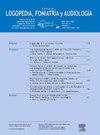少数群体疾病患者的交际模式和功能比较分析:Syngap1和脆性X
Q3 Nursing
引用次数: 0
摘要
背景和目的发病率为每2 000名居民中有1人患有少数族裔疾病,这些疾病往往会导致复杂的沟通需求和智力残疾。本研究的目的是比较两组患有两种罕见疾病的人的表达交际特征:Syngap1综合征和脆性X综合征。参与者和方法收集13名参与者的信息(7名使用Syngap1: 2名男孩,5名女孩,平均年龄10.27岁;6 .弱势群体。结果在交际方式或功能上没有发现显著差异,除了在非语言交际中,诊断为Syngap1的人更多地使用发声和手势。交流功能的唯一区别是肯定或否认,这在脆性X组中更常见。结论虽然脆弱的X组表现出更强的语言使用能力,但两组都有复杂的沟通需求。本文章由计算机程序翻译,如有差异,请以英文原文为准。
Análisis comparativo de los modos y funciones comunicativas en personas con enfermedades minoritarias: los casos de Syngap1 y de X frágil
Background and aim
Rare or minority diseases, with a prevalence of 1 per 2,000 inhabitants, can often cause complex communication needs and intellectual disabilities. The aim of this study is to compare the expressive communicative profiles in 2 groups of people with 2 rare disease diagnoses: Syngap1 syndrome and Fragile X syndrome.
Participants and method
Information was collected from 13 participants (7 with Syngap1: 2 boys and 5 girls, mean age 10.27 years; 6 with fragile minority.
Results
No significant differences were found in communicative modes or functions, except in non-verbal communication, where people with a Syngap1 diagnosis made greater use of vocalizations and gestures. The only difference in communicative functions was affirmation or denial, which was more frequent in the fragile X group.
Conclusion
Both groups have complex communication needs, although the fragile X group shows greater ability in the use of language.
求助全文
通过发布文献求助,成功后即可免费获取论文全文。
去求助
来源期刊

Revista de Logopedia, Foniatria y Audiologia
Nursing-LPN and LVN
CiteScore
1.10
自引率
0.00%
发文量
28
 求助内容:
求助内容: 应助结果提醒方式:
应助结果提醒方式:


